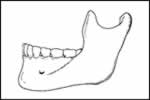Jaw Swinging
- This post is available for download as an audio file, so you can do the work along with the recording.
 The assumption with this exercise is that you’ve already read and done the Jaw Basics exercise; if you haven’t you might want to go and read that.
The assumption with this exercise is that you’ve already read and done the Jaw Basics exercise; if you haven’t you might want to go and read that.
The premise of the Jaw Drop and Jaw Shake exercise is to let your jaw muscles go, so that it hangs freely from your skull. In my teaching, I’ve found that letting you go is easier at first when you shake it very quickly, or very consciously lift it and drop it. In this step, we’ll do the more challenging practice of swinging the jaw more slowly and smoothly, and then add sound to the process.
Stand in alignment, with your head floating up, your neck long and your skull balanced on the top of your neck spine. Let your jaw drop away from you skull, with your tongue relaxed in your mouth behind your lower front teeth. With you mouth open, take a few moments to breathe and feel the open channel of breath from your mouth down to your core.
 With your thumbs under your chin and your index fingers just below your lower lip, grip your jaw bone firmly. Now, gently swing your jaw open and closed, keeping your tongue relaxed in your mouth. The focus should be on the down and back action, rather than the “closing” action, which is likely to cause your teeth to clack together. Remember to keep breathing, and try to find a smooth action to the swinging.
With your thumbs under your chin and your index fingers just below your lower lip, grip your jaw bone firmly. Now, gently swing your jaw open and closed, keeping your tongue relaxed in your mouth. The focus should be on the down and back action, rather than the “closing” action, which is likely to cause your teeth to clack together. Remember to keep breathing, and try to find a smooth action to the swinging.
You may notice some gripping places in the action of your jaw, and for those with jaw disorders (usually called “TMJ Disorder” for Temporo-Mandibular Joint Disorder by those in the medical profession), your jaw might not swing with an even opening and closing action. You may have some clicking if your jaw joint pops in and out of joint: if you do, you might need to stop and consult your physician. Be careful with how you do this–be sure that there is never any side to side action in the jaw movement, only up and down, like the action of biting into something soft and tender. Take it easy, and don’t force it.
Once you’ve swung your jaw for a bit on breath, you should then add a gentle sigh to the process. As always, we’ll work on “huh” (IPA [hʌ]̃) for this exercise. Start around the middle of your range and sigh your Jaw Swinging out very gently. Can you feel the vibrations in your face?
Remember: as always, you have to do this exercise while thinking something. Even if it’s “my this is an absurd thing I’m doing!,” you’ve got to put some content behind the form of the exercise. Remember this is a skill you’re working on for acting, for speaking language. So it’s vital that you think about something concrete and communicate while you’re doing this task.
- This post is also available for download in a condensed, simplified format, so that, once you’ve learned the exercise, you can do the work along with the recording and combine it with other condensed format podcasts to make a warm-up playlist.
Next Step: Small Tongue Rolls